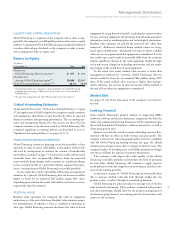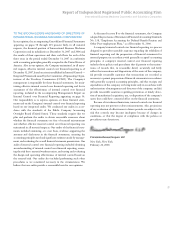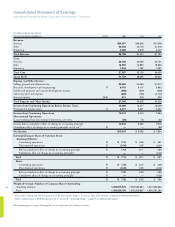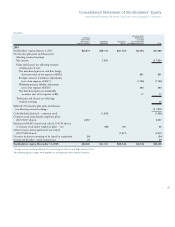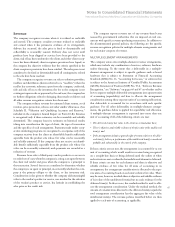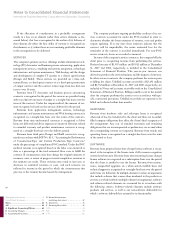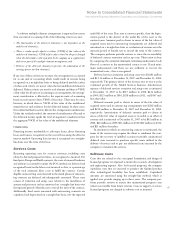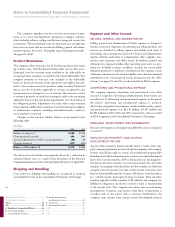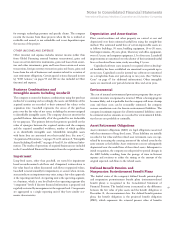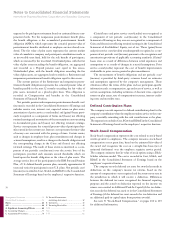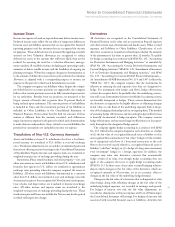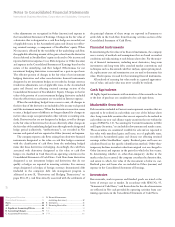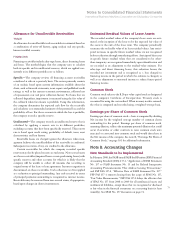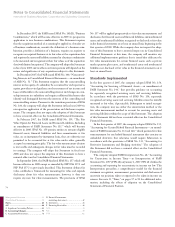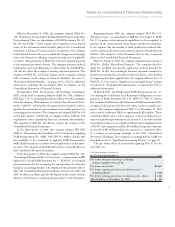IBM 2007 Annual Report Download - page 67
Download and view the complete annual report
Please find page 67 of the 2007 IBM annual report below. You can navigate through the pages in the report by either clicking on the pages listed below, or by using the keyword search tool below to find specific information within the annual report.65
Notes to Consolidated Financial Statements
International Business Machines Corporation and Subsidiary Companies
Revenue
The company recognizes revenue when it is realized or realizable
and earned. The company considers revenue realized or realizable
and earned when it has persuasive evidence of an arrangement,
delivery has occurred, the sales price is fixed or determinable and
collectibility is reasonably assured. Delivery does not occur until
products have been shipped or services have been provided to the
client, risk of loss has transferred to the client, and either client accep-
tance has been obtained, client acceptance provisions have lapsed, or
the company has objective evidence that the criteria specified in the
client acceptance provisions have been satisfied. The sales price is not
considered to be fixed or determinable until all contingencies related
to the sale have been resolved.
The company recognizes revenue on sales to solution providers,
resellers and distributors (herein referred to as “resellers”) when the
reseller has economic substance apart from the company, credit risk,
title and risk of loss to the inventory, the fee to the company is not
contingent upon resale or payment by the end user, the company has
no further obligations related to bringing about resale or delivery and
all other revenue recognition criteria have been met.
The company reduces revenue for estimated client returns, stock
rotation, price protection, rebates and other similar allowances. (See
Schedule II, “Valuation and Qualifying Accounts and Reserves,”
included in the company’s Annual Report on Form 10-K). Revenue
is recognized only if these estimates can be reasonably and reliably
determined. The company bases its estimates on historical results
taking into consideration the type of client, the type of transaction
and the specifics of each arrangement. Payments made under coop-
erative marketing programs are recognized as an expense only if the
company receives from the client an identifiable benefit sufficiently
separable from the product sale whose fair value can be reasonably
and reliably estimated. If the company does not receive an identifi-
able benefit sufficiently separable from the product sale whose fair
value can be reasonably estimated, such payments are recorded as a
reduction of revenue.
Revenue from sales of third-party vendor products or services is
recorded net of costs when the company is acting as an agent between
the client and vendor and gross when the company is a principal to
the transaction. Several factors are considered to determine whether
the company is an agent or principal, most notably whether the com-
pany is the primary obligor to the client, or has inventory risk.
Consideration is also given to whether the company adds meaningful
value to the vendor’s product or service, was involved in the selection
of the vendor’s product or service, has latitude in establishing the
sales price or has credit risk.
The company reports revenue net of any revenue-based taxes
assessed by governmental authorities that are imposed on and con-
current with specific revenue-producing transactions. In addition to
the aforementioned general policies, the following are the specific
revenue recognition policies for multiple-element arrangements and
for each major category of revenue.
MULTIPLE-ELEMENT ARRANGEMENTS
The company enters into multiple-element revenue arrangements,
which may include any combination of services, software, hardware
and/or financing. To the extent that a deliverable in a multiple-
element arrangement is subject to specific guidance such as leased
hardware that is subject to Statement of Financial Accounting
Standards (SFAS) No. 13, “Accounting for Leases,” or software that
is subject to the American Institute of Certified Public Accountants
(AICPA) Statement of Position (SOP) No. 97-2, “Software Revenue
Recognition,” see “Software” on pages 66 and 67 on whether and/or
how to separate multiple deliverable arrangements into separate units
of accounting (separability) and how to allocate the arrangement
consideration among those separate units of accounting (allocation),
that deliverable is accounted for in accordance with such specific
guidance. For all other deliverables in multiple-element arrange-
ments, the guidance below is applied for separability and allocation.
A multiple-element arrangement is separated into more than one
unit of accounting if all of the following criteria are met:
U The delivered item(s) has value to the client on a stand-alone basis;
U There is objective and reliable evidence of the fair value of the undelivered
item(s); and
U If the arrangement includes a general right of return relative to the deliv-
ered item(s), delivery or performance of the undelivered item(s) is considered
probable and substantially in the control of the company.
If these criteria are not met, the arrangement is accounted for as one
unit of accounting which would result in revenue being recognized
on a straight-line basis or being deferred until the earlier of when
such criteria are met or when the last undelivered element is delivered.
If these criteria are met for each element and there is objective and
reliable evidence of fair value for all units of accounting in an
arrangement, the arrangement consideration is allocated to the sepa-
rate units of accounting based on each unit’s relative fair value. There
may be cases, however, in which there is objective and reliable evidence
of fair value of the undelivered item(s) but no such evidence for the
delivered item(s). In those cases, the residual method is used to allo-
cate the arrangement consideration. Under the residual method, the
amount of consideration allocated to the delivered item(s) equals the
total arrangement consideration less the aggregate fair value of the
undelivered item(s). The revenue policies described below are then
applied to each unit of accounting, as applicable.


